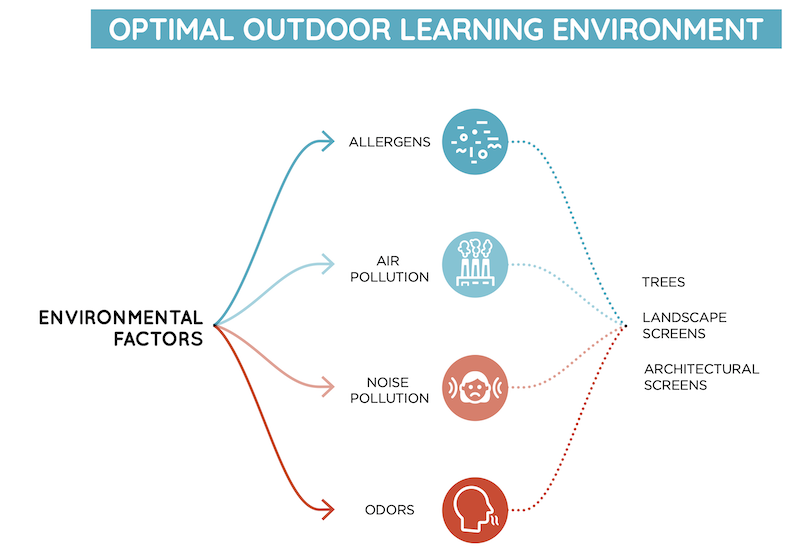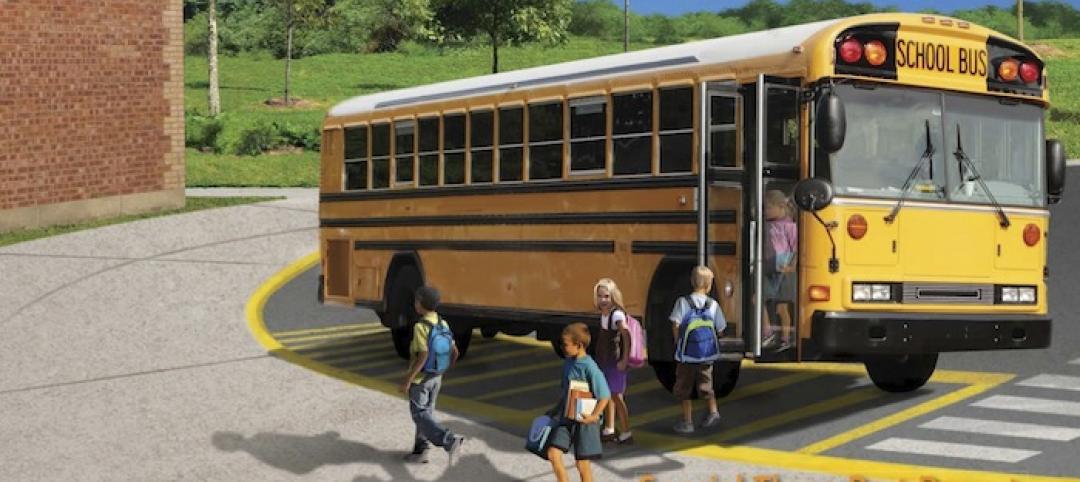As school children have returned to classrooms, school districts are rethinking how outdoor spaces can support the safe return of in-person instruction and lower the risk of virus transmission.
To that end, the Los Angeles County Office of Education has published a 53-page report that provides K-12 schools with Design Guidelines for Outdoor Learning Environments. The AEC firms HMC Architects, the landscape architect AHBE|MIG, the engineering consultant IMEG, and the construction manager Bernards assisted the county in putting together this content.
“Outdoor learning has been proven to offer students a range of benefits, from enhancing engagement to reducing stress and promoting physical and psychological wellbeing,” says Dr. Debra Duardo, Los Angeles County Superintendent of Schools, in the report’s introduction. “When we take lessons outside our classroom walls, we teach our children that learning can happen anywhere and anytime, promoting lifelong curiosity.
“My commitment,” she continues, “is to advocate for a collective investment in such approaches, surrounding our most vulnerable students with the resources they need to succeed and fostering positive, healthy learning environments. Increasing opportunities for outdoor learning is essential to advancing educational equity.”
 This schematic shows how various stakeholders can be engaged when devising how schools should design outdoor learning environments. Charts and graphics: Los Angeles County Office of Education
This schematic shows how various stakeholders can be engaged when devising how schools should design outdoor learning environments. Charts and graphics: Los Angeles County Office of Education
Any guideline, the report states, begins with identifying the project team, its goals, schedule, and budget. Site assessments should include stakeholders and AEC professionals.
To encourage stakeholder engagement, the report is big on conducting workshops that establish the project’s vision, share images, and gather input. Workshops can help to keep teachers abreast of a project’s progress and serve as forums for comment about opportunities related to outdoor learning environments. The report also recommends a “student visioning exercise” in the form of a video that teachers create and show to students, to assist in customizing the learning experience.
At the conclusion of this process, districts will be able to update their Local Control and Accountability Plan to include outdoor learning, which can be incorporated into safety protocols for reopening schools.
 Setting goals for outdoor learning environments must consider many factors.
Setting goals for outdoor learning environments must consider many factors.

WEIGHING PROS AND CONS OF SPACE COMPONENTS
The bulk of the county’s report focuses on outdoor learning space components that include:
Seating: Student seating is one of the key components to having agility for the space. But there are any number of factors to consider: Will the seating remain outdoors, or be moved to a different location each day? Will chairs be chained together and fixed to security points? Can natural elements, like large rocks or tree stumps, serve as seating? Can seating double as desks for students? The report also provides guidelines and considerations for the use of existing furniture, built-in benches, and seat walls.
Shade and Protection. After an assessment of site conditions, the school community must decide its level of tolerance for varying environmental conditions and then the extent to protect the outdoor learning environment from them. The extent of overhead cover needed, for example, can impact the schedule, scope, and budget for a project. The different types of overhead cover to consider are permanent or temporary, fixed or movable, architectural or landscape, or a combination of the two.
The Department of State Architect (DSA), the regulatory agency overseeing public school design and construction in California, has streamlined its review and approval of these structures, which nevertheless must comply with current codes for accessible paths of travel, grading and drainage, restroom location/accessibility, and their distance from the school. The report provides guidelines for umbrellas, tents, and custom shade structures, all of which should be wind- and weather-resistant.
Teaching tools and resources. The report offers considerations and recommendations for the outdoor use of individualized rolling storage, movable water supplies, outdoor white and black boards, outdoor storage (“prefabrication options can be inexpensive,” the report suggests), and power ports.
Space definitions. Defining boundaries around the outdoor learning space “can help to delineate between different activities taking place in an outdoor setting,” the report states. Elements that can define these spaces include movable walls, permanent walls and fences (anything higher than 4 ft requires DSA approval), and planting screens and boxes. The report suggests that districts think about including solar-powered ports in the design and construction of these barriers.

The design guidelines advise that the parameters and programming for outdoor learning be established early.
Site landscaping. The report contends that the physical proximity to plants, and the wildlife attracted to them, helps reduce student anxiety, depression, and stress that can inhibit focus and motivation.
“Students concentrate better when they are not distracted by discomfort and irritation,” says the report. “Plants, such as trees and shrubs, enhance physical comfort. They provide shade, filter airborne pollutants, screen out glare, generate refreshing sounds, and create a soothing sense of human scale.” The report’s guidelines aim to protect plants and their survival, and assert that projects should identify species best suited to the growing conditions of the school.
Site infrastructure and Construction. The report offers guidelines for providing outdoor learning environments with water, electrical power, and technology. It touches as well on the logistics of construction. “The key for any contractor is to remember that we are guests in your home. As such, the approach for projects that entail site work and utility replacement on operational campuses is to carefully coordinate construction activities with school staff relating to the daily school schedule.” Minimizing disruption with an eye toward safety and health are the goals.
The report urges school districts to include outdoor learning experiences in their funding and bidding proposals, and notes that, since last December, school districts may award contracts up to $50,000 directly to consultants without going through a public bid process. For construction or reconstruction of facilities, the bid threshold is $15,000.
To test their design process, school districts should follow three steps that take a broad overview of the outdoor learning environments they want to create, define the primary program to figure out where best to locate this space, and develop multiple schemes with a priority list of components and a program for outdoor learning.
As part of their designs, the report recommends that districts include systems of modular blocks to provide a flexible solution for many component types.
Related Stories
| Mar 26, 2014
Callison launches sustainable design tool with 84 proven strategies
Hybrid ventilation, nighttime cooling, and fuel cell technology are among the dozens of sustainable design techniques profiled by Callison on its new website, Matrix.Callison.com.
| Mar 20, 2014
Common EIFS failures, and how to prevent them
Poor workmanship, impact damage, building movement, and incompatible or unsound substrate are among the major culprits of EIFS problems.
| Mar 17, 2014
Rem Koolhaas explains China's plans for its 'ghost cities'
China's goal, according to Koolhaas, is to de-incentivize migration into already overcrowded cities.
| Mar 12, 2014
14 new ideas for doors and door hardware
From a high-tech classroom lockdown system to an impact-resistant wide-stile door line, BD+C editors present a collection of door and door hardware innovations.
| Mar 4, 2014
If there’s no ‘STEM crisis,’ why build more STEM schools?
Before you get your shorts in a knot, I have nothing against science, technology, engineering, or even mathematics; to the contrary, I love all four “STEM” disciplines (I’m lying about the math). But I question whether we need to be building K-12 schools that overly emphasize or are totally devoted to STEM.
| Feb 26, 2014
Adaptive reuse project brings school into historic paper mill
The project features nontraditional classrooms for collaborative learning, an arts and music wing, and a technologically sophisticated global resource center.
| Feb 14, 2014
Crowdsourced Placemaking: How people will help shape architecture
The rise of mobile devices and social media, coupled with the use of advanced survey tools and interactive mapping apps, has created a powerful conduit through which Building Teams can capture real-time data on the public. For the first time, the masses can have a real say in how the built environment around them is formed—that is, if Building Teams are willing to listen.
| Feb 5, 2014
'School Security' PDF available to BD+C readers - CORRECTED
I've received several requests from BD+C readers who design and build K-12 schools about the 3-part series we ran in our January issue ("Can Design Prevent Another Sandy Hook?"). They wanted to send the issue to their school boards and other public officials with responsibility for school safety. In light of the importance of this topic, as a special service to our readers we're making the series available in PDF form.
| Feb 5, 2014
Extreme conversion: Atlanta turns high-rise office building into high school
Formerly occupied by IBM, the 11-story Lakeside building is the new home for North Atlanta High School.
| Jan 30, 2014
What to expect in the metal building industry in 2014
Every year brings changes. This one won’t be any different. We’ll see growth in some areas, declines in others. Here’s a little preview of what we’ll be writing about 2014 when 2015 comes rolling in.

















